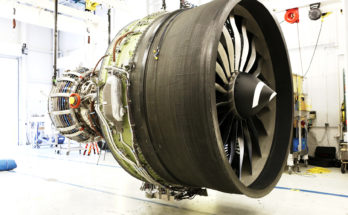by Richard Pettibone, Aerospace & Defense Companies Analyst, Forecast International.
With the recent boom in commercial aircraft orders over, focus now turns to fulfilling the tremendous backlogs both Airbus and Boeing have accumulated. The boom was driven in large part by airlines’ desire for more fuel-efficient aircraft and the engines that power them.
Taking advantage of this environment, Pratt & Whitney strengthened its commercial operations, which have, in the past, lagged behind the company’s more robust military engine segment. The company bought out partner Rolls‑Royce’s stake in the IAE consortium in mid-2012. This gave Pratt the lion’s share of IAE, which produces the V2500 engine for the Airbus A320. Now, Pratt & Whitney can offer customers the standard A320 package or the newer PW1100G for the A320neo. This packaging ability mirrors that of one of its major rivals in the A320 re-engining market – CFM International with its LEAP program.
Central to Pratt & Whitney’s commercial strategy is its new PW1000G geared turbofan engine. This new family of next-generation commercial and business jet engines – offering double-digit improvements in fuel burn, environmental emissions, engine noise, and operating costs – is expected to be a cornerstone product for the firm in the years ahead. The PW1000G program is in high gear, with five engine variants currently in development, one each for Mitsubishi’s MRJ, the Bombardier CSeries, Airbus’ A320neo, Embraer’s E2 family, and Irkut’s MC-21 narrowbody jet. According to Pratt, the PW1000G program could earn as much as $325 billion over the life of the aircraft programs for which it has been selected. Such solid performance is what is guiding the company’s management to set a goal of doubling revenue to $24 billion over the next eight years.
However, the program has not been without its pitfalls. In early 2016, Pratt was working on resolving two key problems with the new PW1100G engine: temperature-induced engine shaft bowing, which required extended start-up times, and false warning indications sent to the pilots’ displays by the Full Authority Digital Engine Control (FADEC) software. These teething issues are being resolved through hardware and software updates, and deliveries are beginning to ramp up.
Further down the line, Pratt will benefit from a solid aftermarket for its base of new engines. As airlines keep flying at a steady pace, the need for maintenance and spares will remain solid. Pratt & Whitney has been investing in partnerships and joint ventures worldwide to serve this growing requirement. As such, Pratt & Whitney is bullish on its aftermarket as it seeks to garner more long-term maintenance contracts.
On the military side, Pratt & Whitney continues to be in a strong position. Pratt’s F135 is the sole power source for the F-35 Joint Strike Fighter, the USAF’s largest active engine program. Other programs of note include positions on the KC-46A tanker and the upcoming B-21 bomber. These opportunities will be critical for Pratt’s military engine operations as programs such as the F100, F117, and F119 transition from production to more MRO-related activities.
The Defense & Aerospace Companies series focuses on worldwide aerospace and defense prime contractors and subcontractors. Concise reports provide data on individual corporations regarding recent mergers, restructurings, and joint ventures, along with a Strategic Outlook that examines the company’s strengths, weaknesses, and opportunities. Also included in each report are financial and industrial segment data, snapshot coverage of major programs, and recent U.S. Department of Defense contract awards.
A military history enthusiast, Richard began at Forecast International as editor of the World Weapons Weekly newsletter. As the Internet grew in importance as a research tool, he helped design the company's Forecast Intelligence Center and currently coordinates the EMarket Alert newsletters for clients. Richard also manages social media efforts, including two new blogs: Defense & Security Monitor, covering defense systems and international issues, and Flight Plan, which focuses on commercial aviation and space systems. For over 30 years, Richard has authored the Defense & Aerospace Companies, Volume I (North America) and Volume II (International) services. The two books provide detailed data on major aerospace and defense contractors. He also edits the International Contractors service, a database that tracks all the contractors involved in the programs covered in the FI library. More recently he was appointed Manager, Information Services Group (ISG), a new unit that encompasses developing outbound content for both Forecast International and Military Periscope.




